Navigation
Making Global Warming Solutions Locally Relevant and Accessible
Americans throughout the country are becoming increasingly concerned about global warming. According to a recent Zogby poll, 74% are more convinced today that global warming is a reality than two years ago.
Article by By Deborah L. Williams and Heather Benz
Americans throughout the country are becoming increasingly concerned about global warming. According to a recent Zogby poll, 74% are more convinced today that global warming is a reality than two years ago. Now, we want to know what to do to about it, especially how to reduce our emissions and become effective advocates. Individuals want solutions that are relevant to where we live, straightforward, accessible, and easy to implement. With this goal in mind, Alaska Conservation Solutions (ACS) unveiled a new global warming Website in September 2006, available online at www.alaskaconservationsolutions.com.
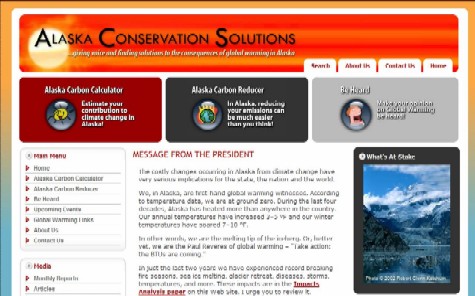 |
Like many places throughout the world, Alaska is experiencing numerous adverse impacts from global warming. Because the annual average temperature in Alaska has warmed over 4 degrees F in the last 50 years, these effects are pervasive in America’s largest and most northern state. Alaskan communities are losing valuable infrastructure to erosion and melting permafrost, and at least three communities will have to be moved in the next 10 to 15 years, costing hundreds of millions of dollars.
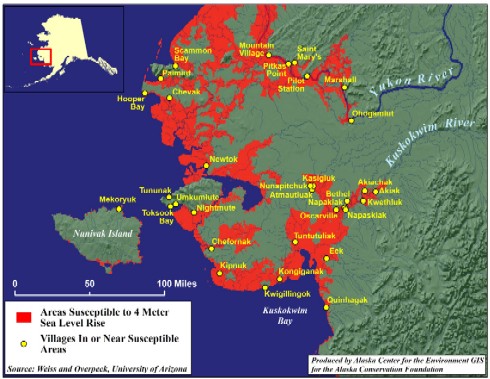 |
Lakes are drying; forests of yellow cedar, white spruce and larch are dying; and polar bears are drowning and may be turning to cannibalism. Sea ice is thinning and retreating, threatening Alaska Native subsistence activities and ice dependent species. The Yukon River alone has warmed 10 degrees Fahrenheit (F) in the last 25 years, resulting in a new, serious disease, Icthyophonus, which is infecting 45% of the river’s Chinook salmon population. Global warming is even adversely affecting oil and gas exploration, production and transportation in Alaska, as well as resulting in buckling highways and bike paths.
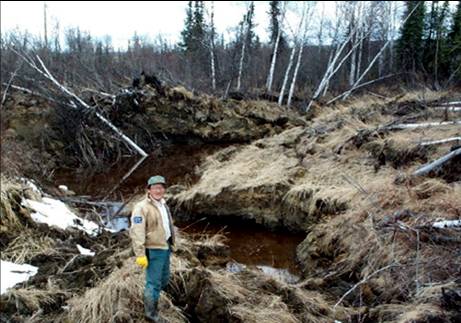 |
| Melting permafrost in Alaska |
All of these effects are costly and disruptive, but they are just the proverbial melting tip of the iceberg. If global warming continues its accelerating trend because of increased human emissions of greenhouse gases, Alaska is projected to warm as much as 25 degrees F by the end of the century. A common response to this is: “what can we do?” “How can we help?”
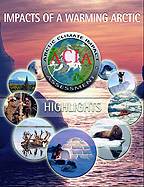 |
| Photo of the Cover of the Arctic Climate Impact Assessment Highlights Document Credit: ACIA (Cambridge University Press 2004) |
These questions especially arise after people understand that “Human activities, primarily the burning of fossil fuels…have increased the concentration of carbon dioxide, methane, and other heat-trapping gases in the atmosphere…There is an international scientific consensus that most of the warming observed over the last 50 years is attributable to human activities,” as noted in the 2004 Arctic Climate Impact Assessment report.
The impacts from global warming in Alaska are amplified, but not unique. On a weekly basis scientists and others are documenting the costly, adverse effects from global warming on other states and countries. Given this stark reality, what are some actions that individuals can take to reduce emissions?
 |
| Montage of Energy Efficient Options Assembled by Jennifer Allen |
Some carbon-based energy conservation actions are very straightforward and do not require state specific information to adopt most easily, such as unplugging appliances when not in use. But many actions are more readily implemented with location specific information, from bus schedules to locations where energy efficient appliances can be purchased.
The Alaska Conservation Solutions website features three hands-on features:
1) An Alaska-specific carbon calculator,
2) Scores of practical, highly linked tips for minimizing personal carbon emissions throughout the state (the Alaska Carbon Reducer); and
3) Sample advocacy letters for taking action at the local, utility, state, and national levels (see the Be Heard section).
Designed by a team of staff, volunteers, and a gifted intern, the goal of the Website is to educate Alaskans about the effects individual residents have on the environment through their carbon footprint, and to offer simple, straightforward, locally relevant methods that can be taken to reduce emissions and often save money. Many of these actions are universally applicable to individuals throughout the nation and world.
 |
Personalized by each region of Alaska, the ACS Carbon Calculator allows individuals to see how much they contribute to global warming by asking a series of simple questions, including vehicle use, flights taken each year, and the cost paid each month for electricity. The calculations can be easily completed in a few minutes.
In order to be responsive to Alaskans’ way of life, the calculator also includes questions about snow machine and other off-road vehicle use and small airplane use. The calculator also explicitly notes how much of a region’s electricity is generated from renewable resources, an important educational component. The Website computes an individual’s average annual carbon emissions, while comparing it with the Alaska average, and then offers a multitude of suggestions to reduce one’s personal emissions.
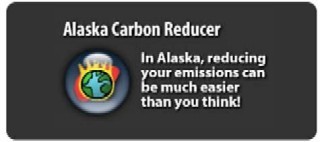 |
Many carbon reduction methods on the Website also save money, such as lowering one’s home thermostat while at work or on vacation.
Ideas and links for reducing emissions are clustered into three categories:
Conservation;
Energy efficiency; and
Renewables.
Conservation
In the conservation category, solutions are grouped into the following actions, all of which have their own linked page with multiple specific recommendations for action in Alaska:
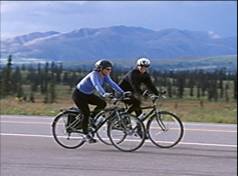 |
| Photograph of Bikers in Alaska |
1) walk, bike, ride public transit, or carpool;
2) make sure your tires are fully inflated and your car tuned up;
3) lower your water heater and home thermostats;
4) reduce your shower length and temperature; 5) only run your dishwasher with full loads;
6) don’t preheat your oven;
7) unplug appliances that are not in use;
8) turn off lights when you leave the room;
9) use recycled paper;
10) recycle as much as you can, or reuse products that are not worn out;
11) buy locally produced food – look for the Alaska Grown logo;
12) cut down on consumerism; and
13) become an eco-friendly tourist.
While the suggestions are specifically for Alaskans, many can easily be implemented elsewhere in the country.
For each action category, there is a background section, followed by a carbon savings section and a “Take Action Now” section. For example, in item (2) above, the “make sure your tires are fully inflated and your car tuned up,” the web site gives important facts such as, “The U.S. government estimates that 4 million gallons of gas are wasted daily due to under-inflated tires!” (Source: pumpemup.org) and that “properly inflating your tires can extend their lives by 25%. (Source: pumpemup.org)”. Furthermore, “if everyone in Alaska maintained appropriate tire pressure, we would save 107 TONS of carbon each year—just from Alaska! (Source: www.stopglobalwarming.org estimates that 250 lbs of carbon is saved each year per car if the tires are kept properly inflated. The DMV had 861,231 vehicles registered in Alaska in 2005.)”
In the “Take Action Now!” section, among other tips and recommendations, there is a link to companies in Alaska that service cars, as well as a link to a more extensive article on proper tire inflation and care, and the site notes that “In the winter, your tire pressure drops 1 or 2 psi for every drop of 10 degrees Fahrenheit. Be sure to check your pressure regularly during the cold season to keep it at the proper level.”
Similarly, other common energy eaters are “phantom” appliances, which use electricity even when turned off. The U.S. Department of Energy estimates that 75% of electricity used in the powering of home electronics is consumed while the electronics are turned off. Section 7 describes the importance of unplugging appliances when not in use.
The sections on Buying Local, Using Transit, and Recycling are especially heavily linked to Alaska specific opportunities. These really are “no excuses” pages for Alaskans, and can potentially serve as models for other states and countries. The website’s goal is to make reducing emissions as easy as possible, and offers a multitude of resources towards this end, to motivate individuals to take action in their lives.
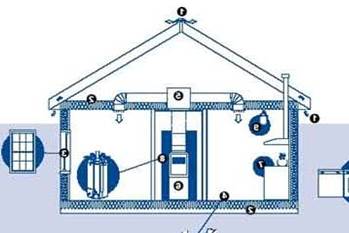 |
| Diagram of energy efficient hot spots in a home Source: Alaska Department of Community and Economic Development |
Energy Efficiency
The Energy Efficiency category features four major highly linked action recommendation pages:
1) Reduce your home's heat and energy losses;
2) Replace incandescent lights with fluorescents;
3) Replace your appliances with “energy star” rated appliances and
4) Buy a hybrid car.
For example, in the first category (Reduce your home’s heat and energy losses), the Take Action section features such linked advice as: Alaska Housing Finance Corporation (AHFC) “has a home energy audit program called AkWarm. You can find info on it and download it to rate your home here. Alternatively, you can have an AkWarm certified technician come to your house and do an energy audit for you. They will show you where your house is losing energy and make recommendations for improvement.
Also, the government has a free Website to help you do a self-audit of your home's energy use. Try it out here. A great resource for tips on how to remodel your home is available from the Departmant of Housing and Urban Development. This resource includes extensive how-to details on each remodeling project, including cost and payback time, modeled to fit your specific home type.
Visit Energy star's interactive home improvement tool for fun tips on both reducing energy consumption and making your home more energy efficient with energy star rated products.
If you are interested in purchasing a new home, Energy Star offers lists of builders, utilities, and financiers in Alaska who build energy star rated homes or who give mortgage discounts on energy star rated homes.
View the list here. Some home improvements are eligible for tax incentives. See this page for more details.”
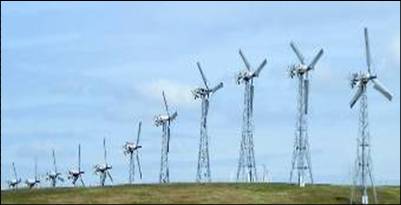 |
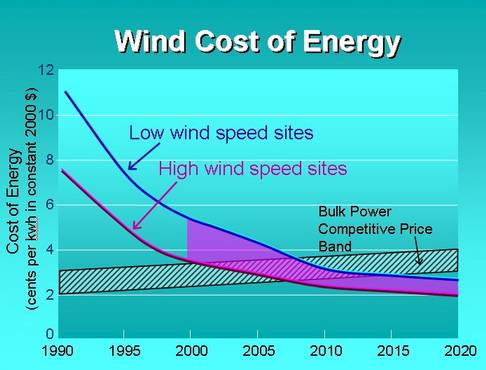 |
| Photo and Graph of Wind Energy, showing economic viability Produced by Chris Rose, REAP |
Renewables
The renewable energy section similarly offers four major highly linked action recommendations:
1) Install a solar panel on your roof to heat water or to generate electricity;
2) Install a wind turbine on your windy property;
3) Install a hydro system in a nearby stream;
4) Use Biofuels to power your car or home generator.
In the wind section, for example, the web site offers such advice as, “This electronic pamphlet by the U.S. Dept of Energy gives a basic explanation of residential wind power systems, as well as offering a map of wind power potential in Alaska. A more detailed map of wind power potential is available from U.S. Dept of Energy here. This website offers basic information about regulations and incentives for wind power in Alaska. This article from Home Power magazine explains the basics of wind power systems, including a diagram of all the different components of the systems. Companies in Alaska providing wind systems for your home.”
For individuals and companies that want to be carbon neutral, the Website provides information on carbon offset options, emphasizing a program that is especially designed to promote renewable energy in Alaska: the Denali Green Tag program run by Bonneville Environmental Foundation.
 |
“Be Heard”
Finally, the Website also includes a “Be Heard” section, where Alaska residents can find easy ways to support change at the local, state, and federal levels. The section discusses current global warming issues in the government in depth and offers example letters to help writers get started. A few topics covered include the U.S Mayor’s Climate Protection Agreement, the 2005 Safe Climate Act, and the Alaska Climate Impact Assessment Commission.
The reaction to the Website has been excellent, both within Alaska and throughout the nation. After extensive media outreach, there was excellent press coverage associated with the unveiling of the Alaska Carbon Calculator and the Alaska Carbon Reducer.
Numerous Alaskans have commented, “Finally, a Website that makes sense for residents of our state.” Others have written and asked, “Is there a Website like this for my state?”
As Heather Benz, a Stanford University freshman and the AKCS intern who was the primary author of the Website observes, “We wanted to give users the resources to not just think about making changes, but also to follow through and carry out these positive changes in their lives. By empowering individuals, especially individuals in a state currently experiencing accelerated effects of global warming, we can begin the fight against global warming while raising awareness of it in our local governments and pushing for a greater global change.
We wanted to provide a valuable resource for Alaskans and others and show that fighting global warming can be both easy and economical. We can all make a difference. We can each reduce our impact and protect Alaska for my generation and the generations to come. The power to stop global warming is in our hands!”
Contact:
Deborah Williams
Alaska Conservation Solutions
308 G Street, Suite 219
Anchorage, AK 99501
(907) 929-9370
http://www.alaskaconservationsolutions.com/
Article written for the Horizon Solutions Site by Williams and Benz.
Deborah L. Williams is the President of Alaska Conservation Solutions. A life-long Alaskan, Heather Benz graduated from East Anchorage High in May 2006, and is attending Stanford University. A National Merit Scholar, Heather has received many awards for her environmental work, including the highest Girl Scout Award, the Gold Award. In 2005 she was named one of 25 “National Young Women of Distinction” for her environmental efforts. Founded in 2005, Alaska Conservation Solutions is devoted to addressing the causes of and solutions to one of the greatest threats facing Alaska – global warming.
See also: Book by Horizon Scientific Review Board Member James Gustave Speth, Red Sky at Morning. James Gustave Speth is Dean of the Yale School of Forestry and Environmental Studies. Speth warns that in spite of all the international negotiations and agreements of the past two decades, efforts to protect Earth’s environment are not succeeding. Still, he says, the challenges are not insurmountable. He offers comprehensive, viable new strategies for dealing with environmental threats around the world. See http://www.redskyatmorning.com/ .
Search
Latest articles
Agriculture
- World Water Week: Healthy ecosystems essential to human health: from coronavirus to malnutrition Online session Wednesday 24 August 17:00-18:20
- World Water Week: Healthy ecosystems essential to human health: from coronavirus to malnutrition Online session Wednesday 24 August 17:00-18:20
Air Pollution
- "Water and Sanitation-Related Diseases and the Changing Environment: Challenges, Interventions, and Preventive Measures" Volume 2 Is Now Available
- Global Innovation Exchange Co-Created by Horizon International, USAID, Bill and Melinda Gates Foundation and Others
Biodiversity
- It is time for international mobilization against climate change
- World Water Week: Healthy ecosystems essential to human health: from coronavirus to malnutrition Online session Wednesday 24 August 17:00-18:20
Desertification
- World Water Week: Healthy ecosystems essential to human health: from coronavirus to malnutrition Online session Wednesday 24 August 17:00-18:20
- UN Food Systems Summit Receives Over 1,200 Ideas to Help Meet Sustainable Development Goals
Endangered Species
- Mangrove Action Project Collaborates to Restore and Preserve Mangrove Ecosystems
- Coral Research in Palau offers a “Glimmer of Hope”
Energy
- Global Innovation Exchange Co-Created by Horizon International, USAID, Bill and Melinda Gates Foundation and Others
- Wildlife Preservation in Southeast Nova Scotia
Exhibits
- Global Innovation Exchange Co-Created by Horizon International, USAID, Bill and Melinda Gates Foundation and Others
- Coral Reefs
Forests
- NASA Satellites Reveal Major Shifts in Global Freshwater Updated June 2020
- Global Innovation Exchange Co-Created by Horizon International, USAID, Bill and Melinda Gates Foundation and Others
Global Climate Change
- It is time for international mobilization against climate change
- It is time for international mobilization against climate change
Global Health
- World Water Week: Healthy ecosystems essential to human health: from coronavirus to malnutrition Online session Wednesday 24 August 17:00-18:20
- More than 400 schoolgirls, family and teachers rescued from Afghanistan by small coalition
Industry
- "Water and Sanitation-Related Diseases and the Changing Environment: Challenges, Interventions, and Preventive Measures" Volume 2 Is Now Available
- Global Innovation Exchange Co-Created by Horizon International, USAID, Bill and Melinda Gates Foundation and Others
Natural Disaster Relief
- STOP ATTACKS ON HEALTH CARE IN UKRAINE
- Global Innovation Exchange Co-Created by Horizon International, USAID, Bill and Melinda Gates Foundation and Others
News and Special Reports
- World Water Week: Healthy ecosystems essential to human health: from coronavirus to malnutrition Online session Wednesday 24 August 17:00-18:20
- STOP ATTACKS ON HEALTH CARE IN UKRAINE
Oceans, Coral Reefs
- World Water Week: Healthy ecosystems essential to human health: from coronavirus to malnutrition Online session Wednesday 24 August 17:00-18:20
- Mangrove Action Project Collaborates to Restore and Preserve Mangrove Ecosystems
Pollution
- Zakaria Ouedraogo of Burkina Faso Produces Film “Nzoue Fiyen: Water Not Drinkable”
- "Water and Sanitation-Related Diseases and the Changing Environment: Challenges, Interventions, and Preventive Measures" Volume 2 Is Now Available
Population
- "Water and Sanitation-Related Diseases and the Changing Environment: Challenges, Interventions, and Preventive Measures" Volume 2 Is Now Available
- "Water and Sanitation-Related Diseases and the Changing Environment: Challenges, Interventions, and Preventive Measures" Volume 2 Is Now Available
Public Health
- Honouring the visionary behind India’s sanitation revolution
- Honouring the visionary behind India’s sanitation revolution
Rivers
- World Water Week: Healthy ecosystems essential to human health: from coronavirus to malnutrition Online session Wednesday 24 August 17:00-18:20
- Mangrove Action Project Collaborates to Restore and Preserve Mangrove Ecosystems
Sanitation
- Honouring the visionary behind India’s sanitation revolution
- Honouring the visionary behind India’s sanitation revolution
Toxic Chemicals
- "Water and Sanitation-Related Diseases and the Changing Environment: Challenges, Interventions, and Preventive Measures" Volume 2 Is Now Available
- Actions to Prevent Polluted Drinking Water in the United States
Transportation
- "Water and Sanitation-Related Diseases and the Changing Environment: Challenges, Interventions, and Preventive Measures" Volume 2 Is Now Available
- Urbanization Provides Opportunities for Transition to a Green Economy, Says New Report
Waste Management
- Honouring the visionary behind India’s sanitation revolution
- Honouring the visionary behind India’s sanitation revolution
Water
- Honouring the visionary behind India’s sanitation revolution
- Honouring the visionary behind India’s sanitation revolution
Water and Sanitation
- Honouring the visionary behind India’s sanitation revolution
- Honouring the visionary behind India’s sanitation revolution

